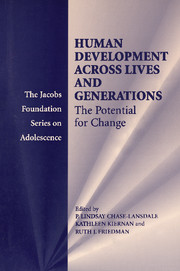Book contents
- Frontmatter
- Contents
- Figures and Tables page
- Contributors
- Foreword
- Acknowledgments
- HUMAN DEVELOPMENT ACROSS LIVES AND GENERATIONS
- Part I Introduction and Overview
- Part II Human Capital
- 3 An Overview of Economic and Social Opportunities and Disadvantage in European Households
- 4 Parental, Childhood, and Early Adult Legacies in the Emergence of Adult Social Exdusion: Evidence on What Matters from a British Cohort
- 5 Individual and Parent-Based Intervention Strategies for Promoting Human Capital and Positive Behavior
- Part III Partnership Behavior
- Part IV Psychological Health and Development
- Part V Conclusion
- Index
4 - Parental, Childhood, and Early Adult Legacies in the Emergence of Adult Social Exdusion: Evidence on What Matters from a British Cohort
from Part II - Human Capital
Published online by Cambridge University Press: 12 October 2018
- Frontmatter
- Contents
- Figures and Tables page
- Contributors
- Foreword
- Acknowledgments
- HUMAN DEVELOPMENT ACROSS LIVES AND GENERATIONS
- Part I Introduction and Overview
- Part II Human Capital
- 3 An Overview of Economic and Social Opportunities and Disadvantage in European Households
- 4 Parental, Childhood, and Early Adult Legacies in the Emergence of Adult Social Exdusion: Evidence on What Matters from a British Cohort
- 5 Individual and Parent-Based Intervention Strategies for Promoting Human Capital and Positive Behavior
- Part III Partnership Behavior
- Part IV Psychological Health and Development
- Part V Conclusion
- Index
Summary
Introduction
Understanding the key factors involved in determining whether people experience a range of disadvantages or are socially excluded in adulthood is a complex and demanding question. Yet exploration of the routes through which people become often lastingly disadvantaged and potentially excluded from normal life is a question of the highest policy relevance. The big picture demands that we attempt to incorporate many challenging issues, including: nature-nurture interplays; the childhood environment, including the home or parental context; emerging individual development characteristics, including personality, health, and educational Performance; the roles of prior experiences, including schooling, employment, housing, welfare, partnership, and childbearing; and the interplays among different elements of disadvantage at any stage in the life course, including whatever point is taken as the “outcome.” A key feature is thus to pay attention to processes over the whole life course and to as füll a ränge of economic, social, behavioral, demographic, genetic, and contextual features as possible, given the inevitable limitations of any source of information. Moreover, there are many deep and interesting issues about the importance of timing, sequencing, and cumulation of experiences over the life course and even more challenging questions about the interplays or interactions involved.
Social exclusion is a concept that is now widely established in European social science and policy dialogue and is increasingly used in the context of developing countries, but has yet to become part of the rhetoric in the United States. Social exclusion is multifaceted, being concerned with the underlying dynamic processes that lead to experiencing some, or all, of the bundle of circumstances deemed to exclude an individual from society. The concept is related to and overlapping with terms such as multiple disadvantage, the underclass, and Sen's capabilities approach (see Hills, Le Grand, & Piachaud 2002; especially Burchardt, Le Grand, & Piachaud, 2002a &b; and Sen, 1999).
There is still much discussion as to what are the key indicators of social exclusion. Some of these debates concern whether different aspects of disadvantage, such as poor physical health, should be deemed exclusionary in their own right, or rather as important precursors of exclusion from “normal” activities (see Burchardt, Le Grand, & Piachaud, 2002b).
- Type
- Chapter
- Information
- Human Development across Lives and GenerationsThe Potential for Change, pp. 63 - 92Publisher: Cambridge University PressPrint publication year: 2004

